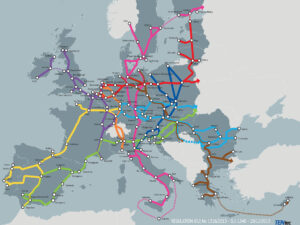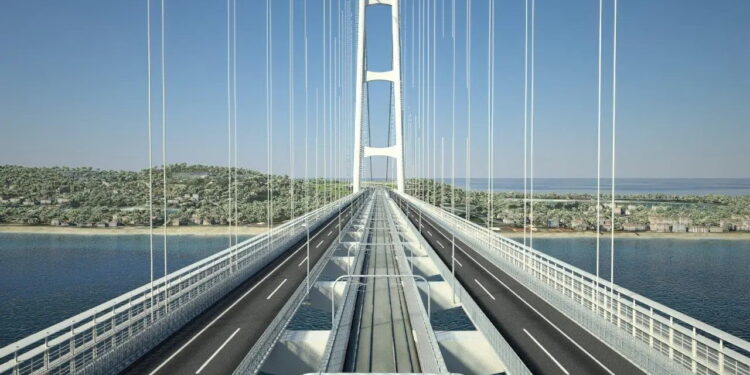Brussels – There were no genuine surprises or risks at the voting test, but it was nonetheless a momentous step that, at least in Italy, is certain to have particular resonance. Today (April 24), the European Parliament gave the green light to the agreement on the updated guidelines for the TEN-T trans-European transport network, including projects such as the Bridge over the Strait of Messina, which will thus be able to obtain European funding in the future through the Connecting Europe Facility.

With 565 votes in favour, 37 votes against, and 29 abstentions, MEPs meeting in plenary session confirmed what was agreed upon by EU Council co-legislators in December last year, with no particular news on the priorities for grounding large-scale cross-border rail network projects, roads, inland waterways and short sea routes connected through ports and terminals throughout the Union, including for example the Helsinki-Warsaw Rail Baltica and the Lisbon-Madrid high-speed rail line. But for Italy, it was a final step (pending the final vote of the 27 EU ministers and publication in the Official Journal) to see included in the TEN-T network not only projects such as the Milan-Treviglio-Verona and Bologna-Ancona-Pescara-Foggia high-speed rail routes and the Brenner Base Tunnel between Italy and Austria, but especially the much-discussed Strait Bridge.
More specifically, it is the “bridge-fixed link” (highway, passenger and freight rail line) between Villa San Giovanni and Messina of the Scandinavian-Mediterranean Corridor, as envisaged by the amendment submitted by the Lega last year and included in the negotiating mandate of the EU Parliament on the Ten-T network review. The amendment was accepted without particular objections at the trialogue stage. It thus arrived in the Strasbourg Chamber for the final go-ahead for the possibility of receiving EU funding in the future for the feasibility study and eventual construction. Even though until now, the Strait of Messina Bridge has never appeared among the interventions to be realized, the European system of transport networks already provides#a link from Scandinavia to Sicily (the Scandinavian-Mediterranean corridor, precisely). The European Commission has never denied either that a link over the Strait of Messina could be considered “essential” or its willingness to finance the first phase of feasibility studies in the face of a solid project to connect Sicily to the rest of the peninsula because the goal is not the construction of the Strait Bridge itself, but the effective interconnection of transport networks across the entire continent, from Helsinki to Palermo.
The TEN-T network beyond the Strait Bridge

The core corridors of the Trans-European Transport Network (Ten-T)
TEN-T is the European cross-border network connecting 424 major European cities that, when completed, will reduce travel time on any means of transportation. The EU Commission presented the proposed revised 2013 Regulation in December 2021 with new time targets for the completion of the network. Still, it was revised in July last year in light of the political and economic consequences of the Russian invasion of Ukraine. The updated guidelines represent the plan for constructing railways, roads, inland waterways, and short sea routes.
Today’s agreement maintained the three-stage approach envisioned in the Commission’s proposal: until 2030 for the core network, 2040 for the extended core network, and 2050 for the comprehensive network. In particular, the new interim deadline of 2040, introduced to bring forward the completion of large-scale projects from the initial target of 2050, should be considered. In parallel, to ensure that infrastructure planning meets “real operational needs” (i.e., an integration of railways, roads, and waterways), the new Regulation also creates nine European transport corridors, which, according to the co-legislators, “are of the highest strategic importance” for the development of sustainable and multimodal transport flows in Europe, both for freight and passengers. In this regard, by 2030, electrified railways in the core TEN-T network will travel at speeds of 160 kilometres per hour for passenger transport and 100 kilometres per hour for freight. They will cross internal EU borders in less than 25 minutes on average, while by 2040, there will have to be a shift to a single traffic management system.

The TEN-T railway network in the Western Balkans
Just in response to the impact of the Russian war in Ukraine, the revised Regulations extend four TEN-T corridors to Ukraine and Moldova while cross-border connections with Russia and Belarus are cut. Also, to ensure better connectivity with key neighbouring countries, network strengthening with Western Balkan partners will continue. On a general level, airports in major European cities with a total annual traffic of more than 12 million passengers will have to be connected to the trans-European rail network. By 2027, all 424 major cities along the TEN-T network will have to establish a sustainable urban mobility plan (zero-emission and with improved walking and cycling infrastructure). The design and upgrading of road transport for civilian use (with measures such as separate roadways for the two directions of travel or separation by a dividing strip not intended for traffic) will also need to consider military requirements (weight and size) when overlapping, to ensure seamless transfer of troops and equipment.
English version by the Translation Service of Withub






